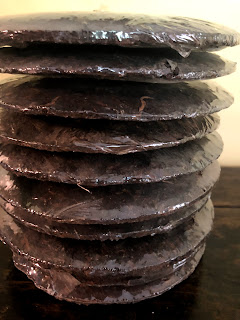When trying to determine the age of an old puerh, I think
vendor information should be taken with a grain of salt. The older a puerh is, the more likely it has
either changed hands, making its real age hard to determine. With the passage of time, its exact age has often
been forgotten. More importantly, if a
vendor is claiming to have a very old tea it is more likely to be fake. Sometimes the vendor was simply given misinformation. Also old puerh never has a date stamped onto
its wrapper during production- that started in the Mid 2000s along with the push
for Quality Control standardization (that blue “Q” you see on the puerh
wrappers). If you are buying aged puerh you
should always always go to the most reputable and trusted of vendors. But if you happen to stumble upon a
potentially old puerh by accident, getting as much information from the seller
will at least give you a starting point.
After picking up two of these old bings, I wanted to go
back and try to get as much information about the cakes as I could from the thick
accented, old, Cantonese herbalist, Thomas Chan. Thomas Chan is a Traditional Chinese
Herbalist and was trained by his father who was tired by his father. The family owned a herbal medicine shop in
the Kowloon peninsula of Hong Kong named Yan Tsu Hong Herbs. The sign in his shop in Regina, Saskatchewan was
made in the 1970s and used to hang in the original Hong Kong location.
When I asked him to tell me about how he acquired the “1970s
puerh” he told me that his family’s herbal shop in Hong Kong was much much
larger than his very very small retail space in Regina. He told me that he initially placed a very
large order of this puerh in the 1970s. He couldn’t remember the exact date but
was sure in was the 1970s.
I asked him, “How many did you order?”
Thomas replied, “500 maybe.” As he motioned with his arms
about the size of a pallet or two full.
“Wow! 500!” I replied.
“Yes, so many”
“Did you do many orders or just get them all in one order?”
“All in one order. When I moved Yan Tsu Hong to Regina in
1993 I might have moved around 300 here.”
“You had 300 of these in Regina?”
“Yes. I only sell a few every year.”
Then, to my surprise, I see another two bings of the same
tea back on the same spot on the shelf!
I had thought I had picked up the last two. It turns out that he has 9 more bings. I offer to buy out all remaining cakes and he
packs me up the remaining cakes. They
are all sealed in plastic and some look a bit redder than others. Some are missing chunks from the edges. Some have zhongcha stickers where some the
zhongcha lable has been rubbed or has aged off.
Some are completely sealed but most are imperfectly sealed with holes
and rips or spots that the plastic didn’t completely cover.
I then go on to ask
him about the storage of the cakes…
“Where were these puerh stored?”
“In my herb shop in Hong Kong and then Regina when I moved
here in 1993.”
“When did you seal each puerh cake in plastic?”
“A long time ago.”
“In Regina?”
Hahaha… “Yes”
“What else can you tell me about this puerh?”
“Nothing. It’s just
old puerh, you know. It’s very good to
promote Digestive Fire in old people.
Old people can’t have new tea like Tie Guan Yin or new puerh. It’s not good for them. All you need is a little bit of this tea every
day, not that much, and it’s good to prevent arthritis. Research in the New England Medical Journal
shows it’s like an anti-inflammatory.”
After pressing him a bit more about the dates of this tea he
just laughs and says in a Cantonese accent, “It’s 70s puerh from my herb shop
in Hong Kong, Ok.”
I guess this is all I can gather about this tea’s
interesting past. Content with this and
9 more of these cakes. I leave the shop
with my arms full of these iron pressed cakes and a big grin.






No comments:
Post a Comment